ARCHITECTURE AS
CULTURAL PRACTICE IN DESIGN
Alexander Lehnerer (AL) in Conversation with
Daniel Gethmann (GAM)
On January 1, 2020, Alex Lehnerer took over the professorship for spatial design at Graz University of Technology. He had previously taught at ETH Zurich and at the University of Illinois in Chicago. His architectural firm Alex Lehnerer Architekten is based in Zurich.
GAM: On their homepage, Alex Lehnerer Architekten write: “We are an architectural firm that builds, writes, and teaches.” Might we say that your objective is to think and practice building, writing, and teaching, all together?
AL: Yes, any other approach would be too academic for me. There has always been a tendency to divide things up into categories due to complexity and hygiene: theory has split from history, history from design and from practice. It is a major goal to once again see these levels as related—also a goal of my work: to not draw distinctions between practice and theory. Of course theory also has its own practice, but to me theory becomes relevant when it is applied to the act of designing and when the designed artifact emerges from this intense reflection in a natural way. Designing is first and foremost a thought process, then all the practical decisions follow.
GAM: You describe architecture as both a cultural and a personal practice. How are these two facets interrelated?
AL: Closely. The practice of design always seeks to find context in the present. But there are also experiences, memories, techniques from the past—combined with a claim to the future. In short, architecture is a contemporary practice by nature. We are influenced by, or even dependent on, an immediate cultural environment. At the same time, we speculate—indeed, similar to activity on the stock exchange—which means that we keep reevaluating the existing situation through design. In the process, we have more or less autonomy, that is, personal freedom. But allowing for such freedom, too, is a personal decision.
GAM: Your professional practice is already very strongly anchored in academic teaching. Since 2012 you have been an assistant professor at ETH Zurich, and prior to that, from 2008 to 2012, a professor at the University of Illinois in Chicago, where you founded the Department of Urban Speculation. What is this all about?
AL: I arrived in Chicago during the period of great financial crisis in the United States, and there were no jobs waiting for university graduates. Because of this, several of us created a small group with the aim of thinking about the future of Chicago and tying this into our teaching. So there were studios, at times headed by students, in which we tried to create a kind of vessel for the speculative reevaluation of our urban environment. Not as politicians or entrepreneurs, but as cheerful amateurs, which, as architects, we of course are.
GAM: Let’s return to your biography. You got your master’s degree from the University of California in Los Angeles before earning your doctorate from the ETH Zurich. Then you returned to the States to teach at the university in Chicago, eventually returning to the ETH...
AL: Yes, I tried to emigrate twice, but both times the school in Zurich called me back (laughs). First as a doctoral candidate, and later as an assistant professor.
GAM: Yet you first started college at the Technical University of Berlin?
AL: Exactly. Then I transferred directly to UCLA, where I first truly felt the challenge of the discipline. The TU Berlin was like a self-service supermarket. Yet in the States, universities were theoretically, ideologically, and polemically charged at that time. Everyone had to first decide how they wished to position themselves. This was new to me. And of course exciting at first. There was always something to advocate and to fight against. An enterprise that can be called discourse.
GAM: And yet you left UCLA for the ETH in order to work on your doctorate.
AL: Yes. After that much of Los Angeles, I had one fundamental question in my mind: What does the city have to do with its individual buildings, and vice versa, the single object with the larger field? I felt that this question could be best answered in a doctoral project. This resulted in the book Grand Urban Rules. With Kees Christiaanse as my doctoral supervisor.
GAM: After writing your dissertation, you then went to Chicago?
AL: Yes, I wanted to return to an American city, which as a cultural phenomenon has always strongly impressed me. With its proud equanimity. The city as something that is simply there—explainable but hard to steer. It is very inspiring for your own intellectual consciousness, but it can also be quite frustrating for one’s work as an architect.
GAM: When did you finally decide to establish your own architectural firm, alongside your university research and teaching, in order to connect these two worlds?
I had a plan. The academic work was supposed to enable me to finance myself, in order to independently fund my own uncompromising architectural practice. This plan went awry. Before I knew it, I was submerged up to my ears in academics. The practical work was nothing more than a fig leaf. I told myself that I had to first write before I could build. But now—after a few disappointments, failures, utter despair, and then finally the right clients—my practice is growing. And I can tell that there is no hierarchy between practice and theory, but rather joyous reciprocal inspiration.
GAM: In the longstanding lecture series “Architectural Research” in our doctoral program at Graz University of Technology, there are speakers with academic research backgrounds and from various architectural firms. We are thus emphasizing how the concept of research in architecture remains more open than in other disciplines. We’re trying to further develop this openness through a certain agenda that involves introducing new and different research concepts, yet without specifying from the outside that these concepts must originate at a university.
AL: For me, the difference lies more in the motivation behind why one does research. I am less interested in promoting a general acquisition of knowledge. Rather, research fascinates me when the work truly involves personal questions that one wishes to have answered. Research, especially in an academic setting, is often accompanied by a discussion on the relevance of architecture, so there is pressure to provide justification. Which I find boring. Instead, I consider a (historical) overview—learning from the actions of our predecessors—to be much more vital for one’s education and becoming of an architect.
GAM: You were hired by Graz University of Technology as a professor of spatial design. I am wondering whether you see any critical potential within spatial design that might put this discipline in a position to also inform other architectural domains?
AL: The idea is always to do projects that make a contribution to their immediate context, for instance as a service for the client, et cetera. But it is also important for a project to make a contribution to the discipline. And in my opinion, it does this best when some kind of criticism of the current state of the field is formulated or an existing question is addressed. Therefore, I don’t believe that architecture possesses many different areas/genres, but rather, at most, a variety of questions. The decernible seeking of appropriate questions (not necessarily answers) is part of any interesting design. This is my understanding of criticality. At issue here is not global commentary, but rather criticism from within—from within one’s own work—using the means that are at architecture’s disposal. Self-criticism always remains the strongest form of criticism.
And what I like about the term “Raumgestaltung” (spatial design) is that it doesn’t suggest a certain scale. What we are doing is lending spatial presence to design, yet space has no scale that needs to be predefined as limitation. This scalelessness is the exciting position of this institute in a department that, as far as I can tell, enjoys a large measure of freedom.


